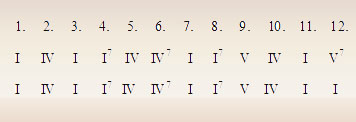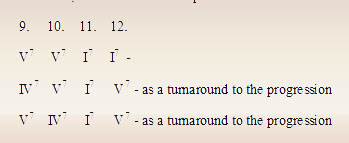12 Bar Blues
This page as a PDF file for download
Twelve-bar and Sixteen-bar blues progressions
The 12 bar blues progression is one of the mainstay progressions of popular music.
It is based on the tonic (I chord), subdominant (IV chord) and dominant (V chord) chords of any of the twelve keys.
It is also very common to add the 7th to these chords.
In the key of C these chords would be C, F and G. With the 7th added this would be C7, F7 and G7.
Note that these are the dominant 7th chords.
A common version of the progression would be by measure:
With the seventh added it looks like this:

The V chord in the twelfth measure allows for a turnaround to repeat the progression.
Variations (excluding chord substitutions – a topic for a later discussion) are primarily in the last four measures, 9. – 12.
Many times there will be a mix of major and dominant chords, with the dominant chords used to facilitate the
turnaround . In this example there is also a variation in the second measure where a IV chord is substituted
for the I chord (known as the quick four):

In the key of C this would be:

For the blues in minor a progression will generally follow this type pattern:

In the key of Em this would be:

A basic jazz blues progression is given in the following example Where there are two chords in a measure,
they each get two beats. There various techniques in the chord substitutions will be covered in a later discussion:

In the key of A this would be:

The sixteen-bar blues progression is usually an extension of the 12 bar form done by repeating one of the
Three four-bar sections. In the four examples below, the repeated section is in red.
First four bars repeated:

Second four bar section repeated:

Third four bar section repeated:

Knowing music theory to the musician is like a painter knowing the color palate. Music theory is sort of like eating your veggies. Not always the tastiest dish on the plate, but one of the most important to a strong mind and body. |


